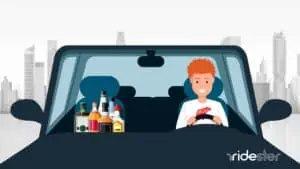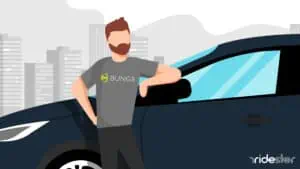Key Takeaways
- DoorDash offers more flexibility with no pre-scheduled shifts required.
- Amazon Flex provides competitive hourly rates, potentially higher earnings.
- DoorDash has broader service availability, operating in more cities.
- Amazon Flex requires more commitment with scheduled delivery blocks.
Side hustles are on the rise thanks to the booming gig economy, and among the most profitable options in the niche delivery are delivery jobs, with Amazon Flex and DoorDash sitting at the top of the pile.
Amazon Flex is a top in-demand courier service closely associated with Amazon and its affiliates, while DoorDash is the most popular delivery service in North America. Both offer you flexible delivery gigs with good earnings.
But which of the two delivery services should you choose? Read on to discover how the two stack up against each other so you can find the ideal platform to work for.
Amazon Flex vs. DoorDash: Comparison at a Glance
As two of the top delivery side hustles, Amazon Flex and DoorDash are often compared.
But despite their similarities, the two apps operate in slightly different niches and have some key differences that may influence your choice.
To help you find your ideal side gig, we’ll compare Amazon Flex and DoorDash based on five categories. Here are the results at a glance:
| Category | Winner | Reason |
|---|---|---|
| Delivery Driver Requirements | DoorDash | Less restrictive vehicle requirements |
| Service Availability | DoorDash | Available in more cities across the U.S. |
| Delivery Driver Compensation | Amazon Flex | Pays a more competitive hourly rate |
| Scheduling and Working Hours | DoorDash | Doesn’t require pre-scheduled shifts to work |
| Mileage Reimbursement | DoorDash | Incentives to supplement the cost of gas |
Delivery Driver Requirements
Both Amazon Flex and DoorDash require potential drivers to satisfy a series of requirements before they can start working for either service.
For example, on both platforms, you’ll need a valid driver’s license, a clean driver’s record, a clean background check, as well as valid automobile insurance.
Beyond these, you’ll need to meet each platform’s unique set of requirements, namely:
Amazon Flex
To apply for Amazon Flex, you must:
- Be at least 21 years old
- Have a Social Security number
Additionally, Amazon Flex requires that your car be a midsize 4-door or larger vehicle in good working condition
DoorDash
To become a DoorDash delivery driver, you must:
- Be at least 18 years old
- Own an iOS or Android smartphone
- Have at least one year of driving experience
DoorDash doesn’t have specific car requirements, thanks to its flexible options. And so you can use any working car, scooter, or bike you have. You may even deliver on foot if the service area you’re in enables it.
Winner
We’re giving this one to DoorDash thanks to its less restrictive vehicle requirements. This also makes the process of signing up much faster and more accessible to new drivers.
Service Availability Across Different Cities
Before choosing your preferred delivery business side gig, you first need to ensure that it operates in your area.
This shouldn’t be an issue for most large cities; however, if you live in a smaller city or town, you might want to check if your preferred app is available.
Amazon Flex
Amazon Flex is slightly limited in terms of availability across the U.S. Currently, the service is only available in 100 cities and towns.
And even though the delivery service is rapidly expanding and adding more locations, drivers can only work in the available areas.
This also means that new Amazon Flex drivers are often waitlisted, especially if there’s competition for spots or when services are unavailable in an area.
DoorDash
DoorDash is available in over 300,000 locations and 7,000+ cities across the U.S. and Canada and is North America’s leading food delivery service.
This wide availability and popularity makes DoorDash one of the top side hustle apps in the country. However, new drivers still get waitlisted, although not as much as on Flex.
Winner
Again, this one goes to DoorDash, thanks to its superior availability. Despite its expansion drive, Amazon Flex’s 100 cities pale in comparison to the thousands of cities where you can access DoorDash and earn an income as a Dasher.
Delivery Driver Compensation
Both Amazon Flex and DoorDash offer a guaranteed minimum rate for every delivery completed.
And while both services offer competitive hourly rates, you should consider additional factors like promotions, incentives, tips, and access to funds before making your choice.
Amazon Flex
Amazon Flex pays a base rate of $18 to $25 per hour, where drivers get paid bi-weekly through direct deposit.
Flex delivery driver earrings also depend on a driver’s location and the time they take to complete their deliveries. Drivers are able to earn tips and boost their income.
Amazon Flex offers its drivers additional opportunities to improve their income.
For example, there are performance-based bonuses, where you can earn extra for completing a predetermined number of deliveries or attaining a high customer satisfaction rating.
DoorDash
DoorDash offers an average hourly pay of about $15, and Dashers receive their pay weekly through direct deposit or a no-charge daily deposit called DasherDirect.
Dashers can also access their money through Fast Pay, which charges a $1.99 transfer fee.
The base pay on DoorDash depends on how long it takes to complete an order and the distance traveled (although most DoorDash orders are usually localized).
Drivers can also earn tips to boost their earnings, in addition to special promotions and peak rates when busy.
Winner
Amazon Flex pulls ahead in this category thanks to its more competitive hourly rate. This makes it easier to earn more, especially given that Flex drivers are almost always guaranteed work.
Scheduling and Working Hours
Delivery drivers on both Amazon Flex and DoorDash have complete autonomy over when they work and how many hours of work they put in each week.
Both platforms allow shift scheduling so you can plan your shifts around other commitments with no minimum hours required.
Amazon Flex
Amazon Flex’s scheduling system requires you to commit to delivery blocks of between two and four hours when you can work. You can only deliver packages if you have a block—and these are assigned on a first-come, first-served basis.
Flex drivers claim these blocks in advance but can cancel a block if they’re unable to work.
However, sometimes securing a block can be difficult, so much so that some drivers use Amazon Flex bots to grab blocks, making it harder if you choose to do so manually.
DoorDash
DoorDash doesn’t impose a mandatory pre-registered delivery block requirement for you to access gigs.
To start working, log in to the driver’s app when you’re ready and take your pick from the available jobs through the Dash Now feature.
Alternatively, you can reserve a few shifts in advance, similar to Amazon Flex, if you want guaranteed work hours.
Winner
DoorDash takes the win in the category because it’s far more flexible than Amazon Flex. Through Dash Now, Dashers are free to choose or decline delivery orders as they see fit.
Note: Be careful not to decline too many orders. While your acceptance rate may not impact your earnings, it does affect your Dasher ratings.
Gas Consumption and Mileage Reimbursement
Gas consumption is a significant consideration since both Amazon Flex and DoorDash are delivery jobs. Gas is one of the biggest expenses for delivery drivers and has a massive impact on your bottom line.
Amazon Flex
Amazon Flex hires drivers on an independent contractor basis; as such, Amazon Flex drivers aren’t eligible for mileage reimbursement—they’re entirely responsible for their fuel and other vehicle costs.
DoorDash
DoorDash also hires drivers on an independent contractor basis. However, unlike Amazon Flex, it incentivizes Dashers through a gas reward program to help ease the cost of gas and protect their earnings.
To qualify for the gas reward program, you must use a prepaid DoorDash card for fuel and meet a set number of deliveries per week.
Dashers who qualify can receive between $1.65 and $2.00 for every gallon toward offsetting their fueling costs.
Winner
DoorDash takes the win in this category. You see, while both Dashers and Flex Delivery drivers must account for fuel and other operation costs, DoorDash’s gas cost-supplementing initiative puts the platform ahead of Amazon Flex and helps keep more money in Dasher’s pockets.
Brett’s Take: Thoughts From an Expert
Some drivers that I’ve talked to report earning more with DoorDash, usually mentioning better pay per mile and less driving.
They appreciate the flexibility to set their own radius for deliveries and the ability to earn a decent amount without excessive driving. In contrast, Amazon Flex is sometimes viewed as more physically demanding and less efficient in terms of earnings per mile.
From what I can tell, earnings and experiences significantly vary depending on the market.
Some users in areas like Los Angeles and St. Louis find Amazon Flex surges lucrative, while others in different locations prefer DoorDash for its consistency and less physical nature.
My Suggestion: Talk to local drivers in your area for both services to get a very good idea on how much you’ll likely make with each service and whether or not that income is worth your time.
Amazon Flex vs. DoorDash: Pros and Cons
There you have it—the key differences between Amazon Flex and DoorDash To complete our in-depth of these two platforms, let’s consider these key pros and cons and their impacts.
Amazon Flex
Pro Fixed Earnings
Amazon Flex’s scheduling system and fixed hourly rate means that drivers know how much they can expect to earn at the end of every shift.
This gives them a better understanding of their earnings and allows them to plan their finances better.
Con :Additional Mileage
Unlike DoorDash, where orders are local, Flex delivery areas can be far apart, driving up mileage expenses. This additional mileage can eat into a driver’s income and negatively impact their profit.
DoorDash
Pro: Flexible Delivery Methods
DoorDash has no vehicle requirements—you can use a car, bike, or scooter to complete deliveries. In select markets, DoorDash even allows deliveries by foot.
This makes the service accessible and allows you to make extra money even if you don’t have a car.
Con: No Guaranteed Work
Gigs on DoorDash depend on your area’s demand. In highly competitive markets or during low demand, you may go without landing a single gig.
Frequently Asked Questions
Which Platform Do Most Drivers Prefer Best: Amazon Flex or DoorDash?
According to our research, it depends on the driver’s priority. Most of them who wanted higher pay chose to work for Amazon Flex, while those who wanted work flexibility chose DoorDash.
Can You Drive for Both Amazon Flex and DoorDash at the Same Time?
Yes, in addition to setting your schedules, another perk of being an independent contractor is that you have free reign over how many delivery services you work for.
Wrapping Up
Both Amazon Flex and DoorDash give you a great opportunity to earn extra money with the freedom to work as much or as little as you please.
From this comparison, we can deduce that DoorDash offers slightly better terms than Amazon Flex. As such, if you’re in the market for a delivery job side hustle, being a Dasher is a safe bet.
However, seasoned independent contractors know that sometimes it’s better to hedge one’s bet through multiple apps. Happy delivering.






